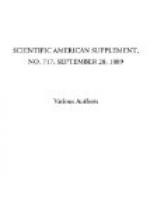This may be induced by corrosion, caused by the presence of sea water, gun metal, and iron, assisted by the rotation of the shaft. It may also be caused under heavy strain, owing to the over-finishing of the shaft at this part under the steam hammer.
The forgemen, in these days of competition and low prices, are instructed to so finish that there won’t be much weight to turn off when completing the shaft in the lathe. This is effected by the use of half-round blocks under the hammer, at a lower temperature than the rest of the forging is done, along with the use of a little water flung on from time to time; and it is remarkable how near a forging is in truth when centered in the lathe, and how little there is to come off. The effect of this manipulation is to form a hard ring of close grain about one inch thick from the circumference of the shaft inward. The metal in this ring is much harder than that in the rest of the shaft, and takes all the strain the inner section gives; consequently, when strain is brought on, either in heavy weather or should the propeller strike any object at sea or in the Suez canal, a fracture is caused at the circumference. This, assisted by slight corrosion, has in my experience led in the course of four months to a screw shaft being seriously crippled.
I show you a section of a screw shaft found to be flawed, and which I had broken under the falling weight of a steam hammer, when the decided difference of the granules near the circumference from that in the central part conveyed to me that it was weakened by treatment I have referred to. I think more material should be left on the forging, and the high finish with a little cold water should be discontinued. Doing away with the outer bearing in rudder post is an improvement, provided the bearing in the outer end of screw shaft in the stern tube is sufficiently large. It allows the rudder post to have its own work to do without bringing any strain on the screw shaft, and in the event of the vessel’s grounding and striking under the rudder post, it does not throw any strain on the screw shaft. It also tends to reduce weight at this part, where all the weight is overhung from the stern of the vessel.
* * * * *




